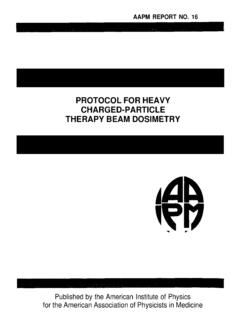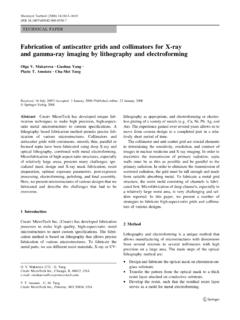Transcription of Dosimetric considerations for patients with HIP …
1 Dosimetric considerations for patients with HIP prostheses undergoingpelvic irradiation . report of the AAPM Radiation Therapy CommitteeTask Group 63 Chester ReftUniversity of Chicago, Chicago, Illinois 60637 Rodica Oncology, Texas Cancer Center, Sherman, TexasIndra J. DasUniversity of Pennsylvania, Philadelphia, PennsylvaniaBruce J. GerbiUniversity of Minnesota Medical School, Minneapolis, MinnesotaPaul KeallVirginia Commonwealth University, Richmond, VirginiaEugene LiefNew York University Medical Center, New YorkBen J. MijnheerNetherlands Cancer Institute, Amsterdam, NetherlandsNikos PapanikolaouUniversity of Arkansas Medical SciencesClaudio SibataEast Carolina University School of Medicine, Greenville, North CarolinaJake Van DykLondon Regional Cancer Centre, Ontario, Canada~Received 25 July 2002; accepted for publication 10 February 2003; published 30 May 2003!
2 This document is the report of a task group of the Radiation Therapy Committee of the AAPM andhas been prepared primarily to advise hospital physicists involved in external beam treatment ofpatients with pelvic malignancies who have high atomic number~Z!hip prostheses . The purpose ofthe report is to make the radiation oncology community aware of the problems arising from thepresence of these devices in the radiation beam, to quantify the dose perturbations they cause, and,finally, to provide recommendations for treatment planning and delivery. Some of the data andrecommendations are also applicable to patients having implanted high-Z prosthetic devices such aspins, humeral head replacements.
3 The scientific understanding and methodology of clinical dosim-etry for these situations is still incomplete. This report is intended to reflect the current state ofscientific understanding and technical methodology in clinical dosimetry for radiation oncologypatients with high-Z hip prostheses . 2003 American Association of Physicists in Medicine.@DOI: #Key words: hip prosthesis, dose perturbationTABLE OF CONTENTSI. 1163II. RADIATION PHYSICS considerations .. 1163 III. HIP prostheses 1166IV. QUANTIFICATION OF THEPERTURBATIONS PRODUCED BYPROSTHETIC DEVICES IN THE ABSORBEDDOSE 1167A. Beam attenuation 1168B.
4 Treatment planning and manual dosecalculation 11691. Beam 11692. Current TPS limitations and 11723. Neutron 1174V. POSSIBLE ACTIONS FOR MINIMIZING THEDOSE 1175A. Special beam 1176B. Dose 1177VI. 117811621162 Med. Phys. 30 6 , June 20030094-2405 2003 30 6 1162 21 $ 2003 Am. Assoc. Phys. INTRODUCTIONThe success or failure of radiation therapy treatments de-pends upon the accuracy with which the dose prescription isfulfilled. For many diseases, the outcome of the treatmentdepends upon the dose being delivered to an accuracy of63% 4%~one standard deviation!.1,2 This is a stringent re-quirement for routine treatments and is difficult to achieve ifall sources of treatment uncertainty are evaluated.
5 Most ofthe national and international guidelines3 7for consistencyand accuracy in radiation dosimetry provide information forhomogeneous media, but the human body consists of manycomponents that deviate significantly from unit density, ,bone, lung, teeth, air cavities, and small intercalated spaceswithin bone. In addition to these naturally occurring internalinhomogeneities, man-made materials may also be presentsuch as mandibular plates for reconstruction, hip, leg, andarm prostheses , spinal cord fixation devices, surgical rods,stents, and various dental fillings. In this report we focus onhip prostheses . These devices are usually made from highatomic number~high-Z!
6 Elements. In this study high-Z isdefined as a material with atomic number greater than corti-cal bone. In megavoltage photon beams these materials havethe potential to greatly affect the dose delivered to the pre-scription point and to tissue shielded by the prosthesis. Con-sequently, dramatic differences in the treatment outcomefrom what was originally intended can the population ages and the use of hip prostheses be-come more common, the problem of treating these patientswill also increase. Although at this time there are few datashowing a decrease in tumor control due to the reduced tar-get dose from shadowing of the prosthesis, or an increase inthe complication rates due to the dose perturbation by thepresence of metallic implants, problems could arise in thefuture.
7 In groin irradiation for gynecological malignanciesusing opposed anterior/posterior fields, Grigsbyet hip fractures in patients at doses greater than 50 , to the best knowledge of this group, no quantitative dataare available on the effects of the increased dose at the in-terface between a hip prosthesis and surrounding tissue inpatients undergoing radical treatment of tumors in the pelvicregion. However, if dose escalation continues in treating pel-vic tumors, the decreased tumor dose and the increased dosenear the bone-metal interface could become factors in tumorcontrol and radiation complications such as bone necrosisand weakening of the fixation of the survey of 30 institutions conducted by this task groupshowed that the number of patients with prosthetic devices,which could affect their radiation therapy, was 1% 4% ofthe total number of patients .
8 No general consensus on how tomanage the treatment of these cases was observed. Someinstitutions ignore the presence of the device institutions modify the beam orientation to avoid thedevice even if the result is to give additional dose to criticalstructures adjacent to the planning target volume. Sometimestreating through sensitive structures is an appropriate solu-tion to the problem if the total prescribed dose is low enoughso that the resultant dose to the structure is below the toler-ance dose. Some institutions try to account for the presenceof the device by using computer treatment planning pro-grams or hand calculations involving a correction for theattenuation of the device.
9 Others may fabricate compensatorsto correct the dose distribution in the target while some mayuse a combination of these approaches. The increasing avail-ability of intensity modulated radiation therapy may offer amethod for treating these patients . All the survey respondentsacknowledged that high-Z devices constitute a problem withthe patient s treatment and that recommendations for dealingwith these situations would be useful. In response to theseconcerns, this task group was formed to identify the prob-lems caused by the presence of high-Z hip prostheses in pel-vic megavoltage photon radiation treatments. Practical sug-gestions are given for dealing with the presence of prosthesesand to minimize, or at least quantify, their undesired effects,while reducing the impact to the surrounding critical RADIATION PHYSICS CONSIDERATIONSThe presence of a high-Z inhomogeneity in an irradiatedwater phantom or patient results in attenuation of the radia-tion through the inhomogeneity as well as local perturbationsknown as interface effects.
10 There are numerous reports9 30on attenuation effects in non-tissue-equivalent materials. Fig-ure 1 illustrates the perturbations to the central axis depthdose curve for 6 and 18 MV broad radiation beams incidenton a water phantom containing an infinitely wide 3 cm Co Cr Mo slab from depths 5 to 8 cm. Three dose regions areshown in the figure. Region 1 is a distance greater thandmaxfrom the implant, and regions 2 and 3 are at the proximal anddistal ends of the implant, respectively. The central axisdepth doses in region 1 shown in Figs. 1~a!and 1~b!are at adistance greater thandmaxfrom the inhomogeneity, and illus-trate the effects of absorption and scatter by the implant.













